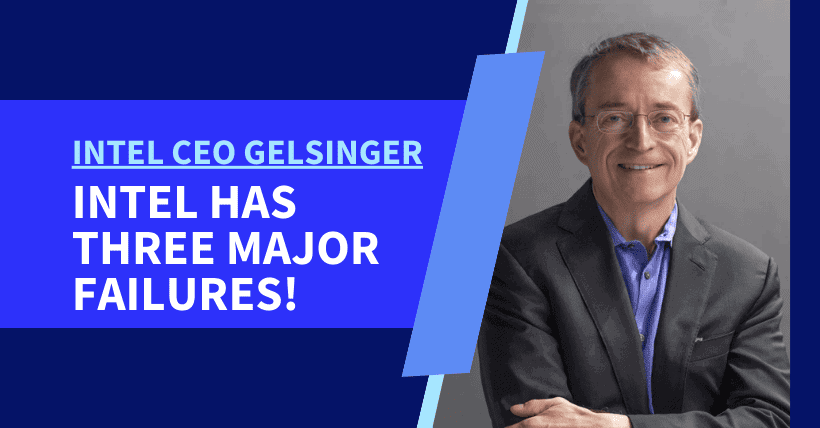In a recent interview with foreign media Digit, Intel’s CEO, Pat Gelsinger, shed light on the company’s historical missteps and outlined a vision for its future. Gelsinger’s candid remarks addressed several key areas where Intel has faced challenges, along with his ambitious plans to steer the company in a new direction.
01
The Smartphone Chip Business: A Historic Misstep
One of the major failures Gelsinger highlighted was Intel’s foray into the smartphone chip business. In 2008, Intel released its first batch of Atom CPUs, specifically designed for smartphones. However, the smartphone market was already dominated by Arm architecture chips, making it challenging for Intel to gain a foothold. Although Intel’s first smartphone using its technology was introduced in 2012, the project eventually met its demise in 2016 due to a lack of progress.
02
The Abandoned Larrabee Project
Gelsinger expressed dissatisfaction with the cancellation of the Larrabee project in 2010, which was an early attempt at creating a general-purpose GPU. Despite initial plans to launch Larrabee for the consumer market and high-performance computing, the consumer-oriented segment was canceled, followed by the entire GPU project. This decision left Intel at a disadvantage in the competitive landscape of artificial intelligence devices, with Nvidia emerging as a dominant player.
Gelsinger believes that had Intel executed a successful GPU plan, it could have been a formidable competitor in the AI device market and not resorted to acquisitions.
03
Intel’s AI Company Acquisitions
Intel’s acquisitions of AI companies have been a mixed bag. Gelsinger’s criticism extended to Intel’s purchase of five AI companies, suggesting that these acquisitions might have been unnecessary if the Larrabee project had succeeded. While he did not specify which acquisitions he was referring to, one of the key points of contention could be Intel’s acquisition of Nervana in 2016, which was discontinued four years later. Similarly, Intel’s $500 million acquisition of DeepLabs in 2014 did not yield significant success.
However, there were bright spots in Intel’s acquisition history, such as the $2 billion acquisition of Habana Labs in 2019, which remains a crucial part of their current AI roadmap. Intel’s more recent $650 million acquisition of Granulate in 2022 is still in the early stages, and its success is yet to be determined.
04
The Focus on Foundry Services
Reports suggest that Gelsinger placed significant emphasis on Intel’s foundry business and its ambition to create a world-class foundry. Although the exact details of his vision remain unclear, it appears that Gelsinger advocates prioritizing foundry services over other aspects of the business. Intel has begun opening its factories to other companies, allowing them to utilize Intel’s advanced manufacturing technology to produce high-performance chips. This approach mirrors the business model of TSMC and Samsung, two leading foundry companies.
Gelsinger believes that by offering semiconductor foundry services to competitors like Nvidia, Intel can generate revenue while simultaneously diverting business from TSMC and Samsung. This strategy not only increases Intel’s funds for investment in manufacturing and research and development but also aligns with Intel’s new IDM 2.0 plan, aimed at opening up foundry services to external customers.
05
The Challenge of Embracing Emerging Trends
Gelsinger acknowledges the challenges of staying ahead in a rapidly evolving industry, as companies often lack full control over emerging trends. Failure to grasp these trends can lead to a regression to square one. As Intel’s CEO, Gelsinger is now leading the company’s transformation, aiming to navigate these trends successfully. While the company has made progress, only time will tell whether Intel can catch the next big wave of change.
In conclusion, Pat Gelsinger’s insights into Intel’s past failures and future ambitions provide valuable context for the company’s ongoing transformation. Intel is not shying away from acknowledging its past missteps and is charting a new course to remain competitive in the ever-evolving tech landscape.
06
FAQs
-
What were Intel’s major failures, as highlighted by Pat Gelsinger?
Pat Gelsinger pointed out three major failures, including Intel’s unsuccessful venture into the smartphone chip business, the cancellation of the Larrabee project, and the company’s limited success with AI company acquisitions.
-
How did the smartphone chip business impact Intel?
Intel’s attempt to enter the smartphone chip business faced challenges, as the market was already dominated by Arm architecture chips. The project ultimately failed due to a lack of progress.
-
What was the Larrabee project, and why was it abandoned?
The Larrabee project was an early attempt at creating a general-purpose GPU. It was abandoned, leaving Intel at a disadvantage in the AI device market, as it could not compete with Nvidia.
-
How have Intel’s AI company acquisitions fared?
Intel’s acquisitions of AI companies have had mixed outcomes. While some, like the acquisition of Habana Labs, were successful, others, such as Nervana, were discontinued.
-
What is Intel’s current strategy regarding foundry services?
Intel is focusing on its foundry business and aims to provide semiconductor foundry services to external companies, including competitors like Nvidia. This approach is aligned with the IDM 2.0 plan, which opens up foundry services to external customers.

Related:








